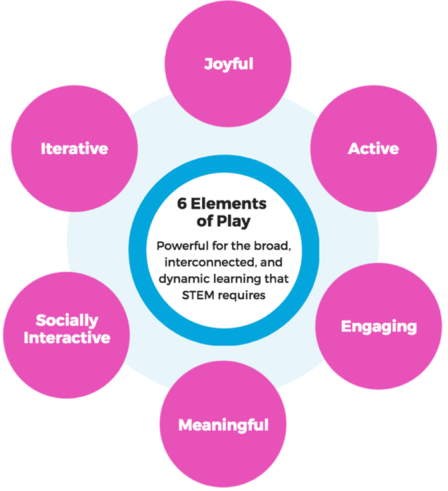Minds On! Learning Through Play Promotes STEM
In this blog, Jennifer Zosh describes the power of playful learning in promoting STEM.
It is hard to imagine, but that little one in front of you with a bowl full of spaghetti poured over his head might be tomorrow’s leading biologist. Or your little girl, who just cannot seem to figure out how potty training works, may be the woman who designs the world’s largest skyscraper in 2058. The truth is that the building blocks for STEM (science, technology, engineering, and math) start early—even in infancy and early childhood. On the one hand, this is great news! This means that children literally have their entire lives to develop the kinds of thinking that will help them to excel in all disciplines in the future (including STEM). But this also raises an all-too-important question: What kinds of experiences today can help build the thinking we want tomorrow?
The truth is that the answer is not nearly as complicated as you may think. Recently, I worked with a team of international collaborators and the LEGO Foundation to review the literature about how children learn and to highlight principles that guide learning. Guess what? The principles that guide learning are the same ones that we find during high-quality play. The play that happens in your living room, in the car, during story time at the library, and even in line at the supermarket is the kind that can help build better brains and more successful adults, and that can help transform today’s spaghetti monster and potty-training-challenged children into tomorrow’s STEM leaders.

This work suggests that play is particularly powerful for learning because it naturally harnesses the following characteristics that support learning:
-
Joyful! Remember the story line of the movie you watched right after a dramatic breakup? No? This is not surprising. Emotions are linked to learning, and joy seems to help promote learning. Now, think of the kind of joy your child feels when immersed in play. You know, the kind of play that you hate to stop because your child is just SO into pretending to be an archaeologist in the backyard. This type of joy seems to help support learning, so by promoting children’s learning during play, you can help them to master dinosaur names more easily in the backyard while they dig in dirt than you can by sitting around with flash cards.
-
Active (minds on)! You know how time just flies when your brain is engaged in thinking about something? Do you remember the thrill of putting in the last puzzle piece? Research suggests (perhaps unsurprisingly) that children learn more when they have to figure something out for themselves or are “minds on” rather than when they are sitting passively and just listening to new information. Supporting the thrill of active discovery is key!
-
Engaged (not distracted)! Remember when the fire alarm would go off in school and you had to go outside for 15 minutes and then return to class? Do you recall the feeling of complete disorientation when you came back inside? Most of the time, you could barely remember what you were even studying! Young children seem to be especially susceptible to distraction, so part of what you can do is help to eliminate some of it. Even things like background TV or “fun” features of apps have been shown to distract children. Try to eliminate outside diversions to help your child learn.
-
Meaningful! What do you think your child would be more interested in building: a random house made out of bricks or a castle that can hold a magical dinosaur? And what is it that you want your child to know—that the triangle in front of him in the app you just purchased is called a triangle or the ability to see triangles, of all different sizes and forms, out in the real world? One of the things that the Science of Learning suggests is that children will: a) be more motivated and b) learn more from contexts that are meaningful to them. This means that drilling with flash cards is much less effective than learning from the real world around us! Learning is not something that happens just at school or in “educational” settings—it happens everywhere!
-
Socially interactive! People are likely the best resources for children. You can help your child by following her interests and supporting (NOT leading) playful interactions. If your child is into animals, support that love and find books that talk about different animals. Relate the animals in the books to the ones you saw in the zoo last summer. No app can do that.
- Iterative! You know how when your little one was in her high chair and she just kept dropping her fork over the side of the tray. Over. And over. And over again? While frustrating for you, this kind of activity is actually the beginning of thinking like a scientist. What will happen this time? What about this time? All parents know that repetition seems to be your toddler’s best friend, but sometimes this repetition and the slight changes your child makes is her experimenting. This kind of thinking, where we take what we know and we learn more by trial and error, is the foundation of STEM thinking.
Don’t read this list and think that children’s experiences must exhibit all of the characteristics 24/7. Instead, think about how play naturally brings the attributes out, and take comfort in the fact that if you support your children’s play, you are helping them to become tomorrow’s leaders (whether they go into STEM fields or not).
LearningThroughPlay
Learning through play: a review of the evidence

|
Jennifer M. Zosh, Ph.D., is an associate professor of Human Development and Family Studies at Penn State University’s Brandywine campus. She is also the director of the Brandywine Child Development Lab where she studies how infants and young children learn about the world around. |
This update is part of a four-part series on family engagement in STEM learning. Join the conversation by sharing this blog with your networks using #FamilySTEM.
Related STEM Series Resource
To learn more about how to support families' STEM learning, check out this video highlighting GFRP's research on family engagement in STEM.
